-
 Bitcoin
Bitcoin $105,113.3912
0.12% -
 Ethereum
Ethereum $2,520.6048
-0.46% -
 Tether USDt
Tether USDt $1.0003
-0.01% -
 XRP
XRP $2.1608
-0.42% -
 BNB
BNB $649.3011
-0.11% -
 Solana
Solana $146.8412
0.91% -
 USDC
USDC $1.0000
0.00% -
 Dogecoin
Dogecoin $0.1743
-1.62% -
 TRON
TRON $0.2725
1.04% -
 Cardano
Cardano $0.6273
-1.01% -
 Hyperliquid
Hyperliquid $40.2681
-1.43% -
 Sui
Sui $2.9603
-1.38% -
 Bitcoin Cash
Bitcoin Cash $443.6439
1.95% -
 Chainlink
Chainlink $13.0988
-0.14% -
 UNUS SED LEO
UNUS SED LEO $9.2161
1.61% -
 Stellar
Stellar $0.2571
-0.70% -
 Avalanche
Avalanche $18.9812
-0.36% -
 Toncoin
Toncoin $2.9584
-1.37% -
 Shiba Inu
Shiba Inu $0.0...01194
-1.68% -
 Litecoin
Litecoin $85.5083
-0.49% -
 Hedera
Hedera $0.1528
-3.98% -
 Polkadot
Polkadot $3.7835
-0.32% -
 Ethena USDe
Ethena USDe $1.0001
-0.04% -
 Monero
Monero $318.3484
1.90% -
 Dai
Dai $1.0000
0.00% -
 Bitget Token
Bitget Token $4.5129
-0.71% -
 Pepe
Pepe $0.0...01115
0.72% -
 Uniswap
Uniswap $7.1870
-1.31% -
 Pi
Pi $0.6066
2.70% -
 Aave
Aave $276.6237
0.39%
Is the bottom accumulation a position building? Where is the main cost area?
Bottom accumulation, a strategy of buying at the lowest price, can be seen as a form of position building, focusing on precise market timing.
Jun 14, 2025 at 05:49 pm
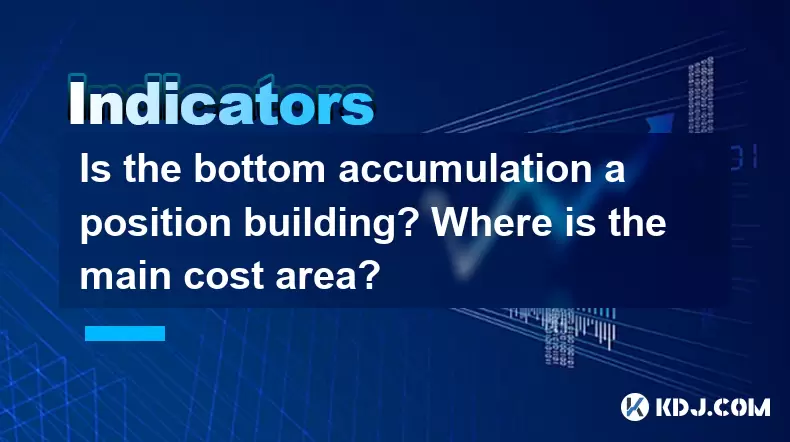
Is the bottom accumulation a position building? Where is the main cost area?
In the world of cryptocurrencies, understanding the concepts of bottom accumulation and position building can be crucial for investors looking to maximize their returns. Bottom accumulation refers to the process of buying an asset when its price is at or near its lowest point, often after a significant decline. Position building, on the other hand, involves gradually increasing one's holdings over time, typically in anticipation of future price increases. This article will delve into whether bottom accumulation can be considered a form of position building and explore where the main cost area might be located in such strategies.
Understanding Bottom Accumulation
Bottom accumulation is a strategy employed by investors who believe that an asset's price has hit a low point and is likely to recover. This approach requires a keen understanding of market trends and the ability to identify when an asset is undervalued. Investors who engage in bottom accumulation often look for signals such as high trading volumes, significant price drops, and positive fundamental developments in the project.
To effectively engage in bottom accumulation, investors must conduct thorough research. This involves analyzing historical price data, understanding the project's fundamentals, and keeping an eye on market sentiment. By doing so, investors can increase their chances of buying at the bottom and benefiting from subsequent price increases.
Is Bottom Accumulation a Form of Position Building?
Position building is a broader strategy that involves gradually increasing one's exposure to an asset over time. It can be executed through various methods, including dollar-cost averaging, where an investor invests a fixed amount of money at regular intervals, regardless of the asset's price. The goal is to reduce the impact of volatility and build a position over time.
Given these definitions, bottom accumulation can indeed be considered a form of position building. When an investor engages in bottom accumulation, they are essentially building a position at what they believe to be the lowest possible cost. This strategy aligns with the overarching goal of position building, which is to increase holdings in anticipation of future gains.
However, it's important to note that bottom accumulation is a more specific and aggressive form of position building. While position building can be done through regular investments over time, bottom accumulation focuses on buying at a perceived low point, which requires precise timing and market analysis.
Identifying the Main Cost Area
The main cost area in the context of bottom accumulation and position building refers to the price range at which most of an investor's capital is deployed. Identifying this area is crucial for understanding the potential profitability of an investment strategy.
To find the main cost area, investors need to analyze their entry points and the volume of their investments at different price levels. Here’s how to do it:
- Collect Data: Gather historical price data for the cryptocurrency in question. This can be done using various cryptocurrency tracking platforms and tools.
- Analyze Entry Points: Identify the price levels at which you entered the market. If you engaged in bottom accumulation, these will likely be at or near the lowest points in the price chart.
- Calculate Average Cost: Determine your average cost per unit of the cryptocurrency by dividing the total amount invested by the total number of units purchased.
- Plot the Cost Area: On a price chart, mark the range of prices at which you made your purchases. The main cost area will be the price range where the majority of your capital was deployed.
By following these steps, investors can pinpoint their main cost area and assess the potential for future gains based on current market conditions.
Factors Influencing the Main Cost Area
Several factors can influence where the main cost area falls in a bottom accumulation strategy:
- Market Sentiment: The overall sentiment of the market can affect the timing and price levels at which investors decide to buy. Positive sentiment can lead to earlier entry points, while negative sentiment might push investors to wait for even lower prices.
- Technical Analysis: Investors often use technical indicators to identify potential bottom points. Indicators such as moving averages, RSI, and support levels can help determine when an asset is oversold and likely to rebound.
- Fundamental Analysis: Understanding the underlying value of a cryptocurrency through fundamental analysis can guide investors in determining whether a price is truly a bottom. This includes evaluating the project's team, technology, and market potential.
- Volume and Liquidity: High trading volumes at certain price levels can indicate strong support and suggest a potential bottom. Conversely, low liquidity can make it difficult to enter or exit positions at desired price points.
Strategies for Effective Bottom Accumulation
To maximize the effectiveness of bottom accumulation and position building, investors can employ several strategies:
- Diversification: Spread investments across multiple cryptocurrencies to mitigate risk. This can help balance the potential losses from one asset with gains from another.
- Risk Management: Set clear stop-loss levels to protect against unexpected market downturns. This can help limit losses if the market does not recover as anticipated.
- Continuous Monitoring: Keep a close eye on market trends and adjust strategies as needed. The cryptocurrency market is highly volatile, and staying informed can help investors make timely decisions.
- Patience: Recognize that bottom accumulation may take time to pay off. It requires patience and a long-term perspective, as prices may not recover immediately.
By implementing these strategies, investors can enhance their chances of success in bottom accumulation and position building.
Tools and Resources for Bottom Accumulation
To aid in the process of bottom accumulation and identifying the main cost area, investors can utilize a variety of tools and resources:
- Cryptocurrency Exchanges: Platforms like Binance, Coinbase, and Kraken provide access to real-time price data and trading volumes, essential for identifying potential bottoms.
- Technical Analysis Tools: Software such as TradingView offers a range of technical indicators and charting tools that can help investors analyze price trends and identify entry points.
- Fundamental Analysis Platforms: Websites like CoinMarketCap and CoinGecko provide detailed information on cryptocurrency projects, including market cap, trading volume, and project developments.
- Community and Social Media: Engaging with cryptocurrency communities on platforms like Reddit, Twitter, and Telegram can provide insights into market sentiment and potential bottom points.
By leveraging these tools and resources, investors can make more informed decisions and enhance their bottom accumulation strategies.
Frequently Asked Questions
Q: How can I tell if a cryptocurrency has reached its bottom?
A: Identifying a bottom can be challenging, but several indicators can help. Look for significant price drops followed by high trading volumes, which can indicate strong buying interest at those levels. Technical indicators such as the Relative Strength Index (RSI) can also signal when an asset is oversold and potentially at a bottom. Additionally, positive fundamental developments in the project can suggest a turnaround.
Q: What are the risks associated with bottom accumulation?
A: Bottom accumulation carries several risks, including the possibility that the price may continue to fall after an investor's entry point. There's also the risk of mistiming the market, as it can be difficult to accurately predict when a bottom has been reached. Additionally, if the project underlying the cryptocurrency fails to deliver on its promises, the price may not recover, leading to potential losses.
Q: Can bottom accumulation be used for short-term trading?
A: While bottom accumulation is typically a long-term strategy focused on buying at low points and holding for future gains, it can also be adapted for short-term trading. However, this approach requires even more precise timing and a higher tolerance for risk, as short-term price movements can be highly volatile.
Q: How does dollar-cost averaging compare to bottom accumulation?
A: Dollar-cost averaging involves investing a fixed amount of money at regular intervals, regardless of the asset's price. This strategy reduces the impact of volatility and does not require precise timing of market bottoms. In contrast, bottom accumulation focuses on buying at perceived low points, which requires more active market analysis and timing. Both strategies aim to build a position over time, but they differ in their approach to entering the market.
Disclaimer:info@kdj.com
The information provided is not trading advice. kdj.com does not assume any responsibility for any investments made based on the information provided in this article. Cryptocurrencies are highly volatile and it is highly recommended that you invest with caution after thorough research!
If you believe that the content used on this website infringes your copyright, please contact us immediately (info@kdj.com) and we will delete it promptly.
- Bitcoin Charges Toward 100K
- 2025-06-15 20:35:12
- DeXe [DEXE] has been strained in recent weeks.
- 2025-06-15 20:35:12
- Monero (XMR) Surges 50% to $317 as This New Meme Coin Promises Even Bigger Gains
- 2025-06-15 20:30:12
- Bitcoin Needs to Hit $171,000 for Realized Price Model to Match Previous Cycle Peaks
- 2025-06-15 20:30:12
- US SEC Ends Investigation into PayPal's PYUSD Stablecoin
- 2025-06-15 20:25:14
- Ethereum Dips Below $1800 as Market Hesitation Sets In
- 2025-06-15 20:25:14
Related knowledge
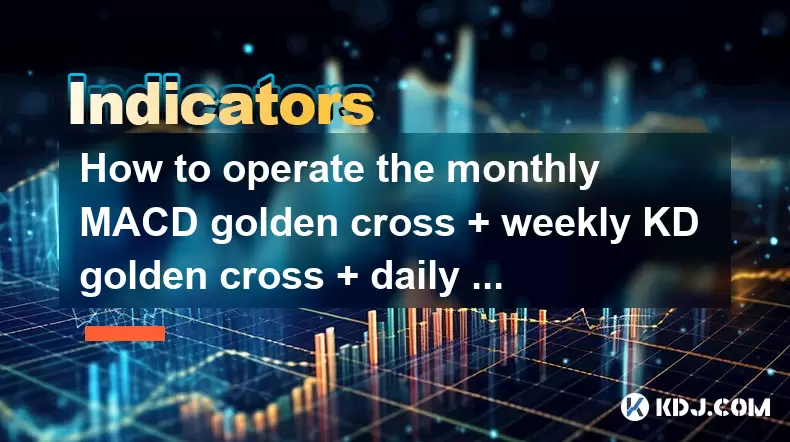
How to operate the monthly MACD golden cross + weekly KD golden cross + daily volume breakthrough?
Jun 15,2025 at 05:36am
Understanding the Strategy: Monthly MACD Golden CrossTo effectively operate the monthly MACD golden cross, traders must first understand what this signal entails. The MACD (Moving Average Convergence Divergence) golden cross occurs when the MACD line crosses above the signal line on a given chart timeframe. When this happens on the monthly chart, it sug...
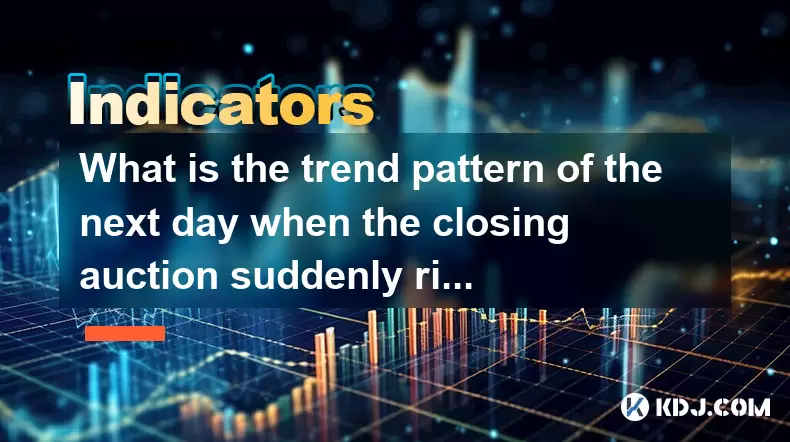
What is the trend pattern of the next day when the closing auction suddenly rises?
Jun 15,2025 at 08:15am
Understanding Closing Auctions in Cryptocurrency MarketsIn the context of cryptocurrency trading, a closing auction refers to a mechanism used by exchanges to determine the closing price of an asset at the end of a trading session. This process typically occurs within a short time window before the market closes for the day and aims to provide a fair an...

What does it mean when the volume fluctuates during the sideways trading at high levels?
Jun 15,2025 at 10:28am
Understanding Volume Fluctuations in Sideways TradingWhen volume fluctuates during sideways trading at high levels, it refers to the changes in the number of assets traded over a given period while the price remains relatively stable, moving within a defined range. This phenomenon typically occurs when the market lacks a clear directional bias—neither b...
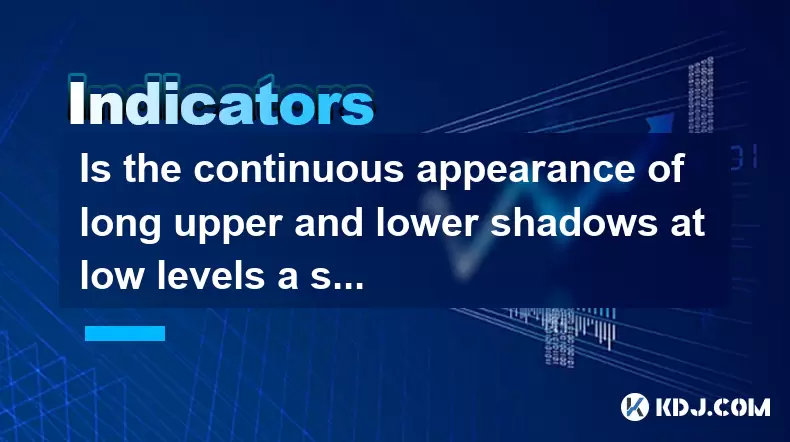
Is the continuous appearance of long upper and lower shadows at low levels a signal of accumulation?
Jun 15,2025 at 01:43am
Understanding Long Upper and Lower Shadows in Candlestick ChartsIn the world of cryptocurrency trading, candlestick patterns are widely used to analyze price movements. A long upper shadow, also known as a wick or tail, indicates that the price rose significantly during the period but was pushed back down by selling pressure. Conversely, a long lower sh...
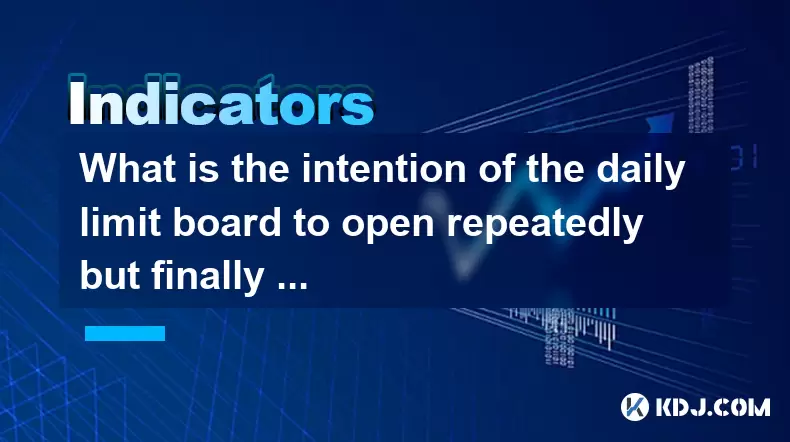
What is the intention of the daily limit board to open repeatedly but finally close?
Jun 15,2025 at 01:08am
Understanding the Daily Limit Board in Cryptocurrency TradingIn cryptocurrency trading, a daily limit board refers to a price movement restriction mechanism applied by certain exchanges or regulatory bodies. This mechanism is primarily used to prevent extreme volatility and panic selling or buying during periods of intense market fluctuation. When an as...

How to calculate the probability of trend continuation after the MACD column divergence?
Jun 14,2025 at 08:01am
Understanding MACD Column DivergenceThe Moving Average Convergence Divergence (MACD) is a widely used technical indicator in cryptocurrency trading. The MACD column, also known as the histogram, represents the difference between the MACD line and the signal line. When price makes a new high or low but the MACD histogram does not confirm this movement, a...

How to operate the monthly MACD golden cross + weekly KD golden cross + daily volume breakthrough?
Jun 15,2025 at 05:36am
Understanding the Strategy: Monthly MACD Golden CrossTo effectively operate the monthly MACD golden cross, traders must first understand what this signal entails. The MACD (Moving Average Convergence Divergence) golden cross occurs when the MACD line crosses above the signal line on a given chart timeframe. When this happens on the monthly chart, it sug...

What is the trend pattern of the next day when the closing auction suddenly rises?
Jun 15,2025 at 08:15am
Understanding Closing Auctions in Cryptocurrency MarketsIn the context of cryptocurrency trading, a closing auction refers to a mechanism used by exchanges to determine the closing price of an asset at the end of a trading session. This process typically occurs within a short time window before the market closes for the day and aims to provide a fair an...

What does it mean when the volume fluctuates during the sideways trading at high levels?
Jun 15,2025 at 10:28am
Understanding Volume Fluctuations in Sideways TradingWhen volume fluctuates during sideways trading at high levels, it refers to the changes in the number of assets traded over a given period while the price remains relatively stable, moving within a defined range. This phenomenon typically occurs when the market lacks a clear directional bias—neither b...

Is the continuous appearance of long upper and lower shadows at low levels a signal of accumulation?
Jun 15,2025 at 01:43am
Understanding Long Upper and Lower Shadows in Candlestick ChartsIn the world of cryptocurrency trading, candlestick patterns are widely used to analyze price movements. A long upper shadow, also known as a wick or tail, indicates that the price rose significantly during the period but was pushed back down by selling pressure. Conversely, a long lower sh...

What is the intention of the daily limit board to open repeatedly but finally close?
Jun 15,2025 at 01:08am
Understanding the Daily Limit Board in Cryptocurrency TradingIn cryptocurrency trading, a daily limit board refers to a price movement restriction mechanism applied by certain exchanges or regulatory bodies. This mechanism is primarily used to prevent extreme volatility and panic selling or buying during periods of intense market fluctuation. When an as...

How to calculate the probability of trend continuation after the MACD column divergence?
Jun 14,2025 at 08:01am
Understanding MACD Column DivergenceThe Moving Average Convergence Divergence (MACD) is a widely used technical indicator in cryptocurrency trading. The MACD column, also known as the histogram, represents the difference between the MACD line and the signal line. When price makes a new high or low but the MACD histogram does not confirm this movement, a...
See all articles

























































































